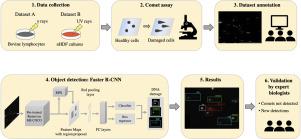Computers in Biology and Medicine ( IF 7.0 ) Pub Date : 2020-07-09 , DOI: 10.1016/j.compbiomed.2020.103912 Riccardo Rosati 1 , Luca Romeo 2 , Sonia Silvestri 3 , Fabio Marcheggiani 3 , Luca Tiano 3 , Emanuele Frontoni 1

|
Background and Objective:
DNA damage analysis can provide valuable information in several areas ranging from the diagnosis/treatment of a disease to the monitoring of the effects of genetic and environmental influences. The evaluation of the damage is determined by comet scoring, which can be performed by a skilled operator with a manual procedure. However, this approach becomes very time-consuming and the operator dependency results in the subjectivity of the damage quantification and thus in a high inter/intra-operator variability.
Methods:
In this paper, we aim to overcome this issue by introducing a Deep Learning methodology based on Faster R-CNN to completely automatize the overall approach while discovering unseen discriminative patterns in comets.
Results:
The experimental results performed on two real use-case datasets reveal the higher performance (up to mean absolute precision of 0.74) of the proposed methodology against other state-of-the-art approaches. Additionally, the validation procedure performed by expert biologists highlights how the proposed approach is able to unveil true comets, often unseen from the human eye and standard computer vision methodology.
Conclusions:
This work contributes to the biomedical informatics field by the introduction of a novel approach based on established object detection Deep Learning technique for evaluating the DNA damage. The main contribution is the application of Faster R-CNN for the detection and quantification of DNA damage in comet assay images, by fully automatizing the detection/classification DNA damage task. The experimental results extracted in two real use-case datasets demonstrated (i) the higher robustness of the proposed methodology against other state-of-the-art Deep Learning competitors, (ii) the speeding up of the comet analysis procedure and (iii) the minimization of the intra/inter-operator variability.
中文翻译:

更快的R-CNN方法,用于检测和定量彗星分析图像中的DNA损伤。
背景与目的:
DNA损伤分析可以在从疾病的诊断/治疗到遗传和环境影响监测的多个领域提供有价值的信息。损害的评估是通过彗星评分确定的,这可以由熟练的操作员以手动程序执行。然而,这种方法非常耗时,并且操作者的依赖性导致损害量化的主观性,从而导致操作者之间/操作者内部的高可变性。
方法:
在本文中,我们旨在通过引入基于Faster R-CNN的深度学习方法来克服这一问题,以完全自动化整个方法,同时发现彗星中看不见的判别模式。
结果:
在两个实际用例数据集上进行的实验结果表明,与其他最新方法相比,该方法具有更高的性能(平均绝对精度为0.74)。此外,由专家生物学家执行的验证程序突出了所提出的方法如何能够揭露通常不是人眼和标准计算机视觉方法可见的真正彗星。
结论:
这项工作通过引入一种基于已建立的对象检测深度学习技术的新方法来评估DNA损伤,为生物医学信息学做出了贡献。主要贡献是通过完全自动化检测/分类DNA损伤任务,将Faster R-CNN用于彗星分析图像中DNA损伤的检测和定量。在两个真实用例数据集中提取的实验结果表明(i)所提出的方法与其他最新的深度学习竞争对手相比具有更高的鲁棒性;(ii)加快了彗星分析过程的速度;以及(iii)运营商内部/运营商之间的差异性最小化。











































 京公网安备 11010802027423号
京公网安备 11010802027423号